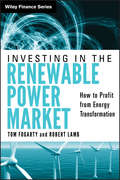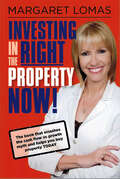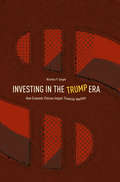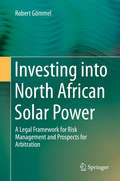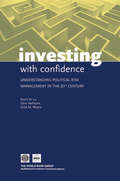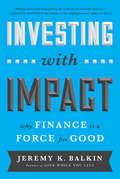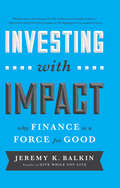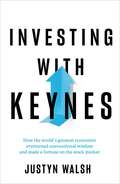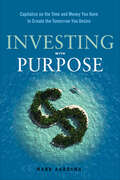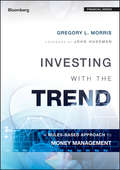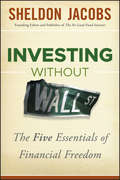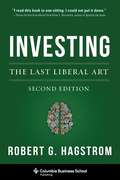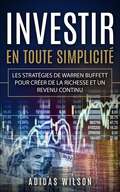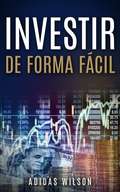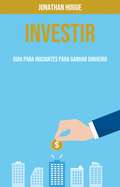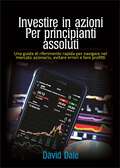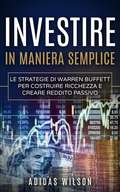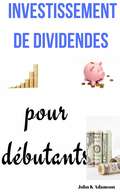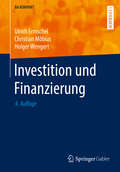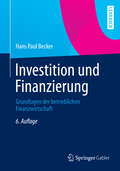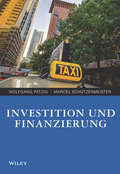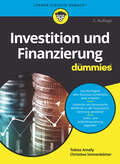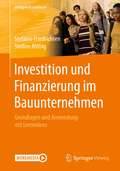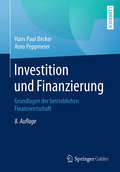- Table View
- List View
Investing in the Renewable Power Market
by Tom Fogarty Robert LambThe financial challenges facing clean energy installations The path to the widespread adoption of renewable energy is littered with major technological legal, political, and financial challenges. Investing in the Renewable Power Market is a reality check for the mass roll out of green energy and its financial dominance of the world energy market, focusing on real energy costs and global energy needs over the next decade. If green energy is to be truly successful, the market must be properly understood, so that dreams of a green future do not lead to actual energy nightmares. The first book to cover the major investing challenges and monetary constraints placed on electric power companies as they race to meet their green energy requirements, Investing in the Renewable Power Market explains how generating electricity is totally different from other energy enterprises in that it is highly regulated and its product cannot be stored. This combination greatly affects the finances of renewable power and influences how investors should navigate the energy market. To help the reader better understand the current state of the alternative energy industry, the book: Details the challenges facing green energy, such as the fact that it is priced compared to natural gas, which is currently at an all-time low Analyzes real energy costs and the global demand for energy over the next decade Describes why, in the short term, investment opportunities with renewable power will be with financial and operational restructurings The green energy market is currently facing enormous challenges, but Investing in the Renewable Power Market explains the real costs of energy, the future of the energy market, and how to profit in both the long and short term.
Investing in the Right Property Now!: The book that smashes the cash flow vs growth myth and helps you buy property today
by Margaret LomasInvestors today need to understand the dynamics of how macro and micro economies operate and how they affect the property markets. Margaret explains this theory in her trademark easy-to-understand style. The book also includes information on:• The current property landscape• Matching property with investors' profiles• Timing the markets to invest when an area is about to take off• Finding strong cash flow and capital growth investments• Recognising growth drivers to find the next hotspot before it becomes one!
Investing in the Trump Era: How Economic Policies Impact Financial Markets
by Nicholas P. SargenIn the wake of the 2016 U.S. presidential election, investors and the electorate alike are seeking clarity on a wide range of macro policy issues that will impact the economy and markets in the years ahead. The primary goal of this book is to provide an objective source for investors to learn about economic policy issues that surfaced. Topics include long-term growth, the federal budget deficit, healthcare reform, tax reform, regulatory policies affecting the financial system and environment, the nexus of monetary, exchange rate and trade policies, and globalization. The book explains how these issues have evolved, considers arguments from both sides of the political divide, and draws upon evidence from studies by experts in the respective areas. A related goal is to assess the likely impact of economic policies on financial markets. While the presidential election was close, the markets’ response was decisive: U.S. and global equity markets went on a tear as consumer and business confidence soared. This surprised many investors who believed a Trump victory would be bad for financial markets. It also caused many to question whether expectations embedded in markets were too optimistic. Sargen’s assessment is presented in the opening and concluding chapters.
Investing into North African Solar Power
by Robert GömmelThis book investigates how a North African solar thermal power plant can be set up under the guidance of European investors (e. g. the Desertec Concept) as a Public Private Partnership (PPP). It outlines the importance of early awareness of contract-related risks, investment risks and dispute settlement, arguing that commercial and investment arbitration are the best tools for settling disputes regarding a large-scale solar thermal project. Furthermore, by comparing institutional and ad hoc arbitration, it shows that the former offers highly suitable support. The latest developments in the area of investment arbitration under EU law and the general acceptance of arbitration in Islamic countries are examined in particular. This book also demonstrates that a solar thermal power plant must meet certain requirements to be considered an investment. These requirements are examined in relation to Art. 25 of the International Centre for Settlement of Investment Disputes Convention (ICSID Convention) and respective case law. Overall, the book offers valuable guidelines for investors and host states on how to successfully implement large-scale solar thermal projects.
Investing with Confidence: Understanding Political Risk Management in the 21st Century
by Kevin W. Lu Gero Verheyen Srilal M. Perera'Investing with Confidence: Understanding Political Risk Management in the 21st Century' is the latest book in a series based on the MIGA-Georgetown University Symposium on International Political Risk Management. The most recent symposium brought together almost 200 senior practitioners from the political risk insurance (PRI) industry, including investors, insurers, brokers, lenders, academics, and members of the legal community. This volume addresses the key issues relevant for investors today, including arbitration, understanding and pricing for risk, and new developments in investments through timely assessments from 15 experts in the fields of international investment, finance, insurance, law, and academia. Contributors to this volume examine key political risk issues including claims and arbitration, perspectives on pricing from private, public and multilateral providers, and explore new frontiers in sovereign wealth funds and Islamic finance. The volume begins with a look back to the founding of International Center for the Settlement of Investment Disputes (ICSID) and MIGA and the respective visions for both of these important institutions. It continues with a review of new developments in global finance and risk management, including Islamic finance and sovereign wealth funds, and provides an investor perspective of what drives the decision making process on procuring political risk insurance. The volume then turns to consider methodologies of pricing from the private, public, and multilateral perspectives, and examines the expropriation and the pledge of shares. This section focuses on key legal questions such as understanding expropriation and the outcome of arbitration hearings, the latter being particularly relevant given the number of cases currently before arbitral panels. The volume concludes with an overview of the key thoughts raised by the authors and the implications for investors going forward. 'Investing with Confidence' offers valuable insights for practitioners and investors alike and is particularly relevant in today's uncertain markets.
Investing with Impact: Why Finance Is a Force for Good
by Jeremy BalkinInvesting with Impact: Why Finance Is a Force for Good outlines the roadmap to reinvigorate a skeptical public and demoralized financial services industry by making the case that contrary to popular misconception, finance is not the cause of the world's problems, in fact, it can provide the solution. Author Jeremy Balkin presents the case that the finance industry can improve the state of the world by positively influencing the allocation of capital.The book explains the methodology of Balkin's 6 E Paradigm, opening the toolbox to this revolutionary framework for the first time. He helps readers assess investing through a different lens. In so doing, Balkin expands the impact investment universe, enabling mainstream capital to flow where opportunities generate positive investment returns and have demonstrable social impact.Described by the Huffington Post as the "Anti-Wolf of Wall Street," Balkin is challenging the status quo on Wall Street by leading the intellectual debate embracing the $1 trillion frontier impact investment market opportunity. The book demonstrates conclusively that, if we can change the culture in finance, we can change the world for the better.
Investing with Impact: Why Finance is a Force for Good
by Jeremy BalkinInvesting with Impact: Why Finance Is a Force for Good outlines the roadmap to reinvigorating a skeptical public and demoralized financial services industry by making the case that, contrary to popular misconception, finance is not the cause of the world's problems; in fact, it can provide the solution. Author Jeremy Balkin presents the case that the finance industry can improve the state of the world by positively influencing the allocation of capital. Investing With Impact explains the methodology of Balkin's 6 E Paradigm, opening the toolbox to this revolutionary framework for the first time. In so doing, Balkin expands the impact investment universe, enabling mainstream capital to flow where opportunities generate positive investment returns and have demonstrable social impact. Described by the Huffington Post as the "Anti-Wolf of Wall Street," Balkin is challenging the status quo on Wall Street by leading the intellectual debate embracing the $1 trillion frontier impact investment market opportunity. The book demonstrates conclusively that, if we can change the culture in finance, we can change the world for the better.
Investing with Keynes: How the World's Greatest Economist Overturned Conventional Wisdom and Made a Fortune on the Stock Market
by Justyn WalshA guide to John Maynard Keynes—one of the greatest economic minds of the twentieth century—for today's investor.John Maynard Keynes was a many-sided figure – world-changing economist, architect of the post-War international monetary system, bestselling author, a Baron in the House of Lords, and key member of the Bloomsbury group. He also had the talent and ability to make vast sums of money in the stock market. At the time of his death, Keynes' net worth—almost entirely built through successful stock investments—amounted to the present-day equivalent of more than $30 million. Additionally, the college endowment fund he managed had massively outperformed the broader market over a two-decade period. Keynes was a member of that rare breed—an economist who flourished not only in the rarefied heights of ivory tower academia, but also amidst the hustle and votility of the financial markets. How does a study of Keynes—the shrewd stock picker and star fund manager—benefit the modern investor? In this volatile era, Keynes' observations on stock market behaviour, in fact, are more relevant than ever. Accessible and informative, this book identifies what modern masters of the market have taken from Keynes and used in their own investing styles—and what you too can learn from one of the most influential economic thinkers of the twentieth century.
Investing with Purpose: Capitalize on the Time and Money You Have to Create the Tomorrow You Desire
by Mark AardsmaA comprehensive, fact-based and experience-proven book . . . covers both the strategic and emotional dimensions [of investing], which are equally critical.” —Dr. John Townsend, New York Times–bestselling authorWhen he was twenty-four years old, Mark Aardsma was fired in a downsizing. He had little in the way of savings. But instead of panicking and seeking to land a new job immediately, he sat down and began to invest his time and money differently. By the time he was thirty-four, he had multiplied his limited savings a thousand fold and controlled a multi-million-dollar portfolio of businesses and other investments. The notes he took as he made his idiosyncratic journey have now been expanded into a detailed guidebook for anyone aspiring to a bigger and better future. In Investing with Purpose, you will learn how to:Use all your resources to build your future, especially your precious, limited time.Avoid the emotional pitfalls that lead smart investors to make bad decisions.Face your fear and take reasonable risks to capitalize on your best opportunities.Apply your unique investment advantages—the only reliable path to superior results.Investing with Purpose will inspire you to use what you have to create the future you want. Whether your goal is to get rich, protect the rainforest, or just improve the neighborhood, this book will help you get there.
Investing with the Trend
by Gregory L. MorrisInvesting with the Trend provides an abundance of evidence for adapting a rules-based approach to investing by offering something most avoid, and that is to answer the "why" one would do it this way. It explains the need to try to participate in the good markets and avoid the bad markets, with cash being considered an asset class. The book is in three primary sections and tries to leave no stone unturned in offering almost 40 years of experience in the markets.Part I - The focus is on much of the misinformation in modern finance, the inappropriate use of Gaussian statistics, the faulty assumptions with Modern Portfolio Theory, and a host of other examples. The author attempts to explain each and offer justification for his often strong opinions.Part II - After a lead chapter on the merits of technical analysis, the author offers detailed research into trend analysis, showing how to identify if a market is trending or not and how to measure it. Further research involves the concept of Drawdown, which the author adamantly states is a better measure of investor risk than the oft used and terribly wrong use of volatility as determined by standard deviation.Part III - This is where he puts it all together and shows the reader all of the steps and details on how to create a rules-based trend following investment strategy. A solid disciplined strategy consists of three parts, a measure of what the market is actually doing, a set of rules and guidelines to tell you how to invest based upon that measurement, and the discipline to follow the strategy
Investing without Wall Street
by Sheldon JacobsPraise for Sheldon Jacobs"Sheldon Jacobs is a level-headed gentleman who is a cross between Albert Einstein, the Dalai Lama, and Vanguard founder Jack Bogle and who had a solid record editing and publishing The No-Load Fund Investor financial newsletter for over a quarter-century."--MarketWatch"King of no-loads."--Investor's Business Daily"Dean of the no-load fund watchers."--USA Today"Among financial experts who are able to think with a small investor's perspective, no one is more level-headed than Sheldon Jacobs."--Bottom Line/PersonalIn July of 1993, Sheldon Jacobs was one of five nationally recognized mutual fund advisors chosen by The New York Times for a mutual fund portfolio competition. The portfolio that he selected produced the highest return of all contestants for almost seven years, and the Times quarterly publication of this contest helped him become one of the best-known mutual fund advisorsin America.Investing without Wall Street shows investors how to achieve the greatest wealth with the least effort. It details the five essentials that even a kid could master and shows that they are all you need to be a successful investor. With this knowledge, the average investor can invest on his or her own and make $252,000 more than a person investing the same way who shares his or her profits with professionals. This book will teach you how.
Investing: The Last Liberal Art (Columbia Business School Publishing)
by Robert HagstromRobert G. Hagstrom is one of the best-known authors of investment books for general audiences. Turning his extensive experience as a portfolio manager at Legg Mason Capital Management into valuable guidance for professionals and nonprofessionals alike, he is the author of six successful books on investment, including The Warren Buffett Way, a New York Times best-seller that has sold more than a million copies. In this updated second edition of Investing: The Last Liberal Art, Hagstrom explores basic and fundamental investing concepts in a range of fields outside of economics, including physics, biology, sociology, psychology, philosophy, and literature. He discusses, for instance, how the theory of evolution disrupts the notion of the efficient market and how reading strategies for literature can be gainfully applied to investing research. Building on Charlie Munger's famous "latticework of mental models" concept, Hagstrom argues that it is impossible to make good investment decisions based solely on a strong knowledge of finance theory alone. He reinforces his concepts with additional data and a new chapter on mathematics, and updates his text throughout to reflect the developments of the past decade, particularly the seismic economic upheaval of 2008. He has also added a hundred new titles to the invaluable reading list concluding the book.
Investir En Toute Simplicite: Les stratégies de Warren Buffett pour créer de la richesse et un revenu continu
by Adidas WilsonTout le monde aspire à la liberté financière. Nombreux sont ceux qui essaient de la trouver en faisant ce qui les passionne. Certains l'ont trouvée en gravissant les échelons de l'entreprise dans laquelle ils travaillent, tandis que d'autres ont créé une affaire. Au cours des cinq dernières années, … Tout le monde aspire à la liberté financière. Nombreux sont ceux qui essaient de la trouver en faisant ce qui les passionne. Certains l'ont trouvée en gravissant les échelons de l'entreprise dans laquelle ils travaillent, tandis que d'autres ont créé une affaire. Au cours des cinq dernières années, on a vu apparaitre plus de millionnaires qu'au cours de toute autre période. Une grande partie de ce succès est dû aux ressources en ligne et à l'internet en général. La plupart de ces personnes ont accepté d'écrire sur leur réussite, de prodiguer des conseils autour du succès et sur ce qu'il convient de faire pour l'atteindre. Une chose qui a été mentionnée dans la majorité des livres est le « secret de la liberté financière ». Quels sont donc ces secrets ? Peu importe combien d'argent vous gagnez: si vous n'avez aucune idée de la façon de le gérer, vous n'atteindrez jamais de liberté financière - vous ne vous en approcherez même pas. Vous devez apprendre à gérer ce que vous gagnez et à développer une culture de l'épargne. Votre argent doit travailler pour vous. Si vous avez des habitudes de dépenses incontrôlables, vous finirez par faire encore moins bien que les personnes qui gagnent beaucoup moins que vous. La première étape vers la liberté financière est l'épargne. Analysez vos habitudes de dépense, contrôlez-les, commencez à établir un budget et à épargner. Ensuite, apprenez à investir votre épargne. Cette décision est l'une des plus importantes de votre vie. Prenez le temps d’effectuer des recherches sur les marchés en croissance. En appréciant ce que vous faites, vous vous rapprocherez de l
Investir de Forma Fácil
by Adidas WilsonDescrição do livro: Todos querem liberdade financeira. Muitos tentam encontrá-la fazendo o que mais gostam de fazer. Há pessoas que a encontraram avançando na empresa onde trabalham enquanto outros abriram um negócio. No período dos últimos cinco anos, surgiram mais milionários do que em qualquer outro período. Recursos online e a internet em geral são responsáveis por muito desse sucesso. Muitas destas pessoas foram boas o bastante para escrever sobre seu sucesso e oferecer conselhos e conhecimento sobre sucesso e sobre o que fazer para atingi-lo. Uma das coisas que foram mencionadas na maioria dos livros são os “segredos para liberdade financeira”. Então, quais são estes segredos? Não importa quanto dinheiro você ganhe, se você não tiver ideia de como administrá-lo você nunca atingirá liberdade financeira — você sequer chegará perto. Você tem de aprender como administrar o que ganha e cultivar uma cultura de economizar. Seu dinheiro tem de trabalhar para você. Se você tiver hábitos de consumo incontroláveis, você acabará se saindo até pior do que pessoas que ganham bem menos do que você. O primeiro passo para liberdade financeira é economizar. Analise seus hábitos de consumo. Controle seus hábitos de consumo e comece a fazer orçamentos e economizar. Depois, aprenda como investir suas economias. Esta está entre as decisões mais importantes de sua vida. Separe um tempo e pesquise sobre mercados em crescimento. Gostar do que você faz o levará mais perto da liberdade financeira que você anseia. Você pode ganhar muito dinheiro, mas levar uma vida miserável porque não gosta do seu trabalho. Se seguir sua paixão, todas as outras coisas se encaixarão. A melhor maneira de escolher uma carreira que você goste é começar uma que utilize seus pontos fortes. Você será um ativo importante para a empresa ou seu negócio. Uma pessoa com objetivos bem definidos é “como um navio com bússola”, indo a uma dire
Investir: Guia Para Iniciantes Para Ganhar Dinheiro
by Bill ThomasNeste livro você irá aprender como fundos de índice funcionam, bem como os riscos e vantagens envolvidas. Você aprenderá as melhores práticas para investir em fundos, pontos-chave para considerar quando investir seu dinheiro e como usar um “plano de custo médio de dólar”. Esse livro te ajudará a investir em índices com mais confiança. Ele dá um passo-a-passo em: · como operar no mercado de ações, tanto em alta quanto em queda; · estratégias de investimento de sucesso em ações; · investir com risco mínimo em opções e mercados futuros; · comprar títulos, tesouro e depósitos de juros. O que está esperando? Não perca mais tempo! Role para cima e clique em comprar agora para iniciar sua jornada para a vida dos seus sonhos!
Investire in azioni per principianti assoluti: Una guida di riferimento rapida per navigare nel mercato azionario, evitare errori e fare profitti
by David DaleVuoi entrare nel mercato azionario come investitore o trader? Hai bisogno delle informazioni giuste per iniziare su una base redditizia? Allora questo libro è ciò di cui hai bisogno. Il trading di azioni e gli investimenti, negli ultimi tempi, sono andati oltre il semplice acquisto e vendita di azioni, poiché la maggior parte delle negoziazioni ora viene eseguita comodamente da casa con un computer. Detto questo, è più facile smarrirsi se non si hanno i prerequisiti necessari o una conoscenza approfondita del mercato finanziario. Questo eBook è la guida che fa per te per comprendere le basi dell'investimento e del trading di azioni e per scoprire le forze di mercato che influenzano il trading. In questo libro ti imbatterai in conoscenze e idee che affineranno le tue capacità e ti metteranno in una posizione di vantaggio nel mercato dei capitali.
Investire in maniera semplice: Le strategie di Warren Buffett per costruire ricchezza e creare reddito passivo
by Adidas WilsonTutti vogliono l'indipendenza economica. Molti cercano di trovarla facendo ciò di cui sono appassionati. Ci sono persone che l'hanno trovata scalando la società in cui lavorano mentre altri hanno iniziato un'attività. Negli ultimi cinque anni, sono emersi più milionari che in qualsiasi altro periodo. Le risorse online e Internet in generale sono responsabili di gran parte di questo successo. Molte di queste persone sono state abbastanza cool da scrivere sul loro successo, offrendo alcuni consigli e informazioni e spiegando cosa fare per ottenerlo. "I segreti per la indipendenza economica" è una delle frasi più menzionate nella maggior parte dei libri che trattano l'argomento. Quali sono questi segreti? Non importa quanti soldi guadagni, se tu non hai idea di come gestirli non otterrai mai la tua indipendenza - non ti ci avvicinerai nemmeno. Devi imparare come gestire ciò che fai e coltivare una cultura del risparmio. I tuoi soldi dovrebbero lavorare per te. Se hai abitudini di spesa incontrollabili, finirai per fare anche peggio di persone che realizzano meno di te. Il primo passo verso l'indipendenza finanziaria è il risparmio. Analizza le tue abitudini di spesa. Controllale e comincia a pianificare e risparmiare. Successivamente, impara come investire i tuoi risparmi. Questa è una delle decisioni più importanti della tua vita. Prenditi il tuo tempo e ricerca i mercati in crescita. Amare quello che fai ti porterà più vicino alla indipendenza finanziaria a cui aspiri. Puoi guadagnare molti soldi ma condurre una vita miserabile perché non ti piace il tuo lavoro. Se segui la tua passione, tutte le altre cose andranno a posto. Il modo migliore per scegliere una carriera che ti piace è raggiungerne una che ti consenta di utilizzare i tuoi punti di forza. Sarai una risorsa importante per l'azienda o per il tuo business. Una persona con obiettivi ben definiti è "come una nave con una bussola", diretta verso una precisa direzione. Se non hai una meta, sar�
Investissement de dividendes pour débutants
by John K AdamsonApprenez les bases pour générer des revenus de dividendes Un manuel de base qui explique les stocks de dividendes pour l'investisseur novice dans un langage clair et non technique. Un manuel de base qui explique les stocks de dividendes pour l'investisseur novice dans un langage clair et non technique. L'auteur explique comment commencer à investir pour créer un revenu en étapes simples, et décrit le « pourquoi » ainsi que le « comment » sans s'enliser dans des détails inutiles ou en utilisant un jargon obscur. Le résultat est une vue d'ensemble des nombreuses façons d'investir pour les revenus de dividendes, et les avantages et inconvénients de chacun. Ce livre répond aux questions de l'investisseur de dividende débutant, comprenant : •Pourquoi l'investissement de dividende est de plus en plus populaire •Comment rechercher des actions de dividendes •Comment acheter des actions de dividendes •Guidage pour trouver et investir dans un plan de réinvestissement de dividendes (RRD) étape par étape •Si les fiducies de placement immobilier (FPI) sont encore viables sur le marché d'aujourd'hui Rapide et facile à lire et rempli d'informations utiles, ce livre décode le mystère de l'investissement de dividendes et montre pourquoi de nombreux investisseurs le considèrent comme un moyen de stabilité dans un marché instable.
Investition und Finanzierung
by Christian Möbius Holger Wengert Ulrich ErmschelDas Lehrbuch "Investition und Finanzierung" ist genau auf das Bachelor-Studium abgestimmt. Ausgehend von einer Einführung in das Finanzwesen und die Finanzmathematik werden die Segmente Investition und Finanzierung eingehend behandelt. Dabei wurde darauf geachtet, den Themenbereich sowohl aus finanztheoretischer als auch aus anwendungsorientierter Sicht zu behandeln. Eine Vielzahl von Abbildungen und Praxisbeispielen tragen zu einer hohen Verständlichkeit der Thematik bei. Durch zahlreiche Übungsaufgaben mit Lösungshinweisen kann der Leser sein Wissen selbständig überprüfen und festigen. Die 2. Auflage wurde im Bereich der Eigenmittelunterlegung (Basel III) und durch weitere Übungsaufgaben ergänzt. Das Lehrbuch richtet sich an Studierende und Dozenten von Bachelor-Studiengängen des Faches Betriebswirtschaftslehre an Dualen Hochschulen, Berufsakademien, Fachhochschulen und Universitäten. Aber auch Praktikern gibt das Buch einen komprimierten Überblick. Online werden zusätzlich Folien für Dozenten zur Verfügung gestellt.
Investition und Finanzierung
by Hans Paul BeckerDas Lehrbuch definiert die Ziele der betrieblichen Investitions- und Finanzpolitik in Unternehmen und erklärt einfach und verständlich die Grundlagen und Methoden der Investitionsrechnung und Finanzierung. Systematisch werden klassische und neue Instrumente vorgestellt, analysiert und bewertet. Beispiele und Aufgaben mit Lösungsvorschlägen ergänzen die Ausführungen. Aufgrund der zunehmenden Bedeutung für die Kreditfinanzierung werden die wesentlichen Regelungen von Basel II und Basel III jetzt in einem gesonderten Kapitel behandelt. Vollständig überarbeitet wurden die Erläuterungen zu Private Equity und Venture Capital sowie zur wichtigsten Finanzierungsart überhaupt: der Abschreibungsfinanzierung. "Gedacht als Lehrbuch, bietet es auch Praktikern einen sehr hilfreichen Überblick." impulse
Investition und Finanzierung (Für Dummies Ser.)
by Marcel Schützenmeister Wolfgang PatzigInvestition und Finanzierung sind zwei verschiedene Seiten derselben Medaille. Unter Investition versteht man die Verwendung finanzieller Mittel in Anlagen, Maschinen oder immaterielles Vermögen, mit dem Ziel, das eingesetzte Kapital zu vermehren. Die Beschaffung dieser eingesetzten finanziellen Mittel ist die Finanzierung. Jeder Wirtschaftswissenschaftler muss sich im Rahmen seines Studiums daher mit diesem Thema auseinandersetzen. Investition und Finanzierung sind elementare Bestandteil der Unternehmensführung. Wolfgang Patzig und Marcel Schützenmeister führen anhand eines durchgängigen Beispiel-Unternehmens in die Grundlagen des Themas ein und zeigen die Ziele finanzwirtschaftlichen Handelns auf. Sie erklären, was Sie zu dynamischen und statischen Verfahren der Investitionsrechnung wissen sollten. Außerdem erläutern sie, was in Risikoanalyse, Finanzplanung, Außen- und Innenfinanzierung wichtig ist. So liefert dieses Buch einen guten und leicht verständlichen Überblick über Investition und Finanzierung. Besonders im Vergleich zu anderen Lehrbüchern ist die Herangehensweise an die Thematik. So steht bei Patzig/Schützenmeister die praktische Anwendung im Vordergrund. Theoretische Modelle werden dann eingeführt und erläutert, wenn sie zur Problemlösung benötigt werden.
Investition und Finanzierung für Dummies (Für Dummies)
by Tobias Amely Christine ImmenkötterInvestition und Finanzierung sind wichtige Themen in der Unternehmenspraxis und im Studium der Betriebswirtschaftslehre. Dieses Buch führt Sie anhand anschaulicher Beispiele in die Grundlagen des Themas ein und zeigt die Ziele finanzwirtschaftlichen Handelns auf. Tobias Amely und Christine Immenkötter zeigen Ihnen die Grundzüge der Finanzwirtschaft und stellen Ihnen die wichtigsten Instrumente sowohl der Außen- und Innenfinanzierung als auch des Finanzmanagements vor. Lernen Sie die statische und dynamische Investitionsrechnung kennen und erfahren Sie, was man über Investitionen in Wertpapiere wissen muss. So liefert Ihnen dieses Buch im bewährten ... für Dummies-Stil einen guten und leicht verständlichen Überblick über alle wichtigen Themen der Investition und Finanzierung.
Investition und Finanzierung für Dummies (Für Dummies)
by Tobias Amely Christine ImmenkötterInvestition und Finanzierung sind wichtige Themen in der Unternehmenspraxis und im Studium der Betriebswirtschaftslehre. Damit Sie damit punkten können, führt dieses Buch Sie anhand anschaulicher Beispiele in die Grundlagen des Themas ein und zeigt die Ziele finanzwirtschaftlichen Handelns auf. Tobias Amely und Christine Immenkötter zeigen Ihnen die Grundzüge der Finanzwirtschaft und stellen Ihnen die wichtigsten Instrumente sowohl der Außen- und Innenfinanzierung als auch des Finanzmanagements vor. Lernen Sie die statische und dynamische Investitionsrechnung kennen und erfahren Sie, was man über Investitionen in Wertpapiere wissen muss. So liefert Ihnen dieses Buch im bewährten ... ???für Dummies-Stil? einen guten und leicht verständlichen Überblick über alle wichtigen Themen der Investition und Finanzierung.
Investition und Finanzierung im Bauunternehmen: Grundlagen und Anwendung mit Lernvideos (erfolgreich studieren)
by Stefanie Friedrichsen Steffen AhtingDieses Lehrbuch vermittelt Studierenden des Bauwesens volks- und betriebswirtschaftliche Zusammenhänge sowie die Grundlagen der Finanzierung, Investitions- und Liquiditätsplanung im Bauunternehmen.Ein durchgängiges begleitendes Fallbeispiel aus der Baubranche veranschaulicht in Form von 39 Lernvideos und Erklärvideos den Lehrstoff und erläutert typische Problemstellungen in Bauunternehmen.Das Lehrbuch ist in der Springer Vieweg Reihe "erfolgreich studieren" erschienen
Investition und Finanzierung: Grundlagen der betrieblichen Finanzwirtschaft
by Hans Paul Becker Arno PeppmeierDas Lehrbuch definiert die Ziele der Investitions- und Finanzpolitik in Unternehmen und erklärt einfach und verständlich die Grundlagen und Methoden der Investitionsrechnung, Finanzierung und Finanzderivate. Systematisch werden klassische und neue Instrumente vorgestellt, analysiert und bewertet. Beispiele und Aufgaben mit Lösungsvorschlägen ergänzen die Ausführungen. Neu in der achten Auflage ist vor allem ein Kapitel über das Capital Asset Pricing Model. Daneben wurden die aufgrund des am 31.12.2015 in Kraft getretenen Gesetzes zur Änderung des Aktiengesetzes notwendigen Anpassungen und Ergänzungen vorgenommen.
